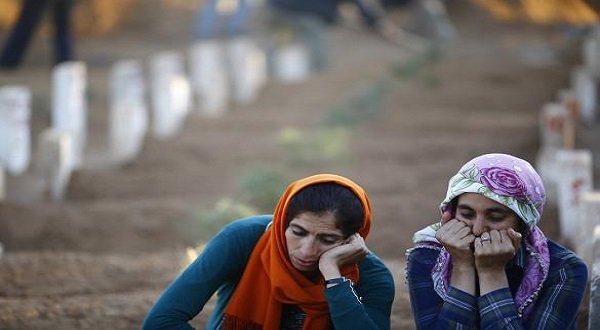
By Michael Williams | Reuters
[dropcap]L[/dropcap]ast week British Foreign Secretary Phillip Hammond said the struggle against Islamic State was “effectively Iraq’s last chance as nation state.”
That somber assessment followed his visit to Iraq a few days earlier, where he had used the expression “last chance saloon” to describe Iraq’s dire predicament.
Iraq, like Syria, was a consequence of World War One and of the infamous, in Arab eyes, agreement between Sir Mark Sykes and Francois-Georges Picot which led to the division of the former Ottoman Turkish domains by the two leading European powers, Britain and France. That agreement, now almost a century old, appears in tatters, as both countries are broken, exhausted by years of war and sectarian division for which there is no easy repair.
In that regard, we might look to Eastern Europe after 1989 for precedents.
Following the collapse of the Berlin Wall, all the countries of Eastern Europe, except two, have moved gradually toward joining the European Union and the North Atlantic Treaty Organization without problems. The former Czechoslovakia broke into two states, the Czech Republic and Slovakia, in what was known as the ‘velvet divorce.’ The fate of Yugoslavia offers a more tragic example. That country broke up in a series of successive wars in Croatia, Bosnia and finally Kosovo, which lasted throughout the 1990s.
Like Syria and Iraq, Czechoslovakia and Yugoslavia, were fashioned into states at the peace conference following World War One at Versailles in 1919. Perhaps Yugoslavia — with its mix of Catholic Slovenes and Croats, Orthodox Serbs and Muslims — resembles most the ethnic and religious diversity of Syria and Iraq.
The two Middle Eastern nations are the most diverse countries in the region, barring tiny Lebanon. Both countries have substantial Sunni, Shi’ite and Christian (of all denominations) communities, as well as smaller numbers of Druze, Yazidis and Alawites. There are also an estimated 30 million Kurds, cited by many as the largest ethnic group in the world without its own state, living in the two countries.
Since independence from Britain and France, Syria and Iraq have been governed with an iron rod. The political narratives of the two key Arab countries have never conceded much of democratic substance in their decades of highly centralized authoritarian rule.
That has now broken down and, most probably, irrevocably. That does not mean that Syria and Iraq will disappear. At the least they are likely to stumble on for some years, but the substance and strength of the two states has drained away. Each is now little more than a collection of fortified and autonomous enclaves fed by outside patrons that include Iran, Saudi Arabia, Turkey and the United States.

In neither country is there one coherent group that is likely to emerge victorious after the years of bloodletting.
In Iraq, years of sectarian bloodletting following the U.S./UK invasion of 2003 have led the three main communities in the country — Sunnis, Shi’ites and Kurds — to go their own ways. This has been aggravated by the Shi’ite-dominated governments in Baghdad having reinforced the tacit dominance of Iran. It is for that reason that Islamic State receives much of its financial and other support from private backers in Saudi Arabia and the other Gulf monarchies.
All of this would not matter were it not for the fact that Islamic State has set as its goal the destruction of the century-old Sykes-Picot imperial diktat and its replacement by a Sunni caliphate stretching from the Persian Gulf to the Mediterranean.

Such a state would of course have no place for Shi’ites, Kurds, Christians and all the other minorities of the region.
In this regard it is worth noting that the Sykes-Picot agreement itself paid little regard to ethnic or religious communities and was anyway changed within years by the British and French. Under the original maps drawn up by the two diplomats, France was allocated not only Syria and Lebanon but also northern Iraq with the present Islamic State capital of Mosul. The French sector also included most of Kurdistan. Britain was to take southern Iraq and what is now Jordan.
Later discussions between French Premier Georges Clemenceau and British Prime Minister David Lloyd George amended this, ceding all of Iraq to Britain. This was confirmed at theinternational conference in San Remo in 1920, which endowed the two countries with mandates from the recently created League of Nations.
The changes in the Sykes-Picot agreement underline the artificiality of what was an inherently imperial project, which paid scant regard to geography, terrain or ethnicity.
Contemporary Syria and Iraq are not alone in this regard.
For most of the period since World War Two, regime and country have been identical in the Arab world. The overthrow of Saddam Hussein’s brutal dictatorship by the United States’ 2003 invasion broke that connection and in so doing has led to the steady erosion of Iraq as a nation state.
War is often the midwife of new states. In modern Europe Croatia, Bosnia-Herzegovina and Kosovo only became states because of the wars of the 1990s.
More recently, East Timor and South Sudan are also new states that have arisen from conflicting former colonial territories. The danger is real that Syria and Iraq may yet give way to new states. What is certainly sure is that a return to strong Syrian and Iraqi states as imagined by Sykes and Picot is highly unlikely.
Michael C. Williams is a former British and UN diplomat with experience in the Middle East, the Balkans and Southeast Asia. He is Distinguished Visiting Fellow at Chatham House (Royal Institute of International Affairs) and a member of the UK House of Lords.


